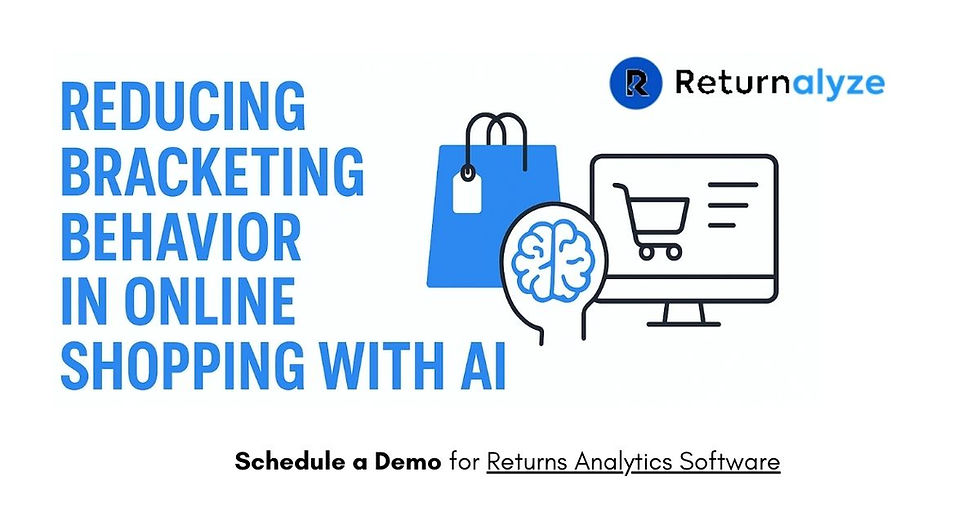Turn Your Refunds into Revenue by Managing the Hidden Costs of E-Commerce Returns
- returnalyze
- Apr 14
- 4 min read

In today’s fiercely competitive digital marketplace, e-commerce returns have emerged as a major cost center for online retailers. What often begins as a simple refund request can escalate into a drain on profitability, operational inefficiencies, and a dent in customer trust.
While generous return policies drive conversion rates, the hidden costs associated with returns, including shipping, restocking, repackaging, lost sales, and reverse logistics, paint a far more complex picture.
According to recent industry studies, the average return rate in e-commerce ranges between 20% to 30%, with categories like fashion and electronics experiencing even higher numbers.
With customer expectations rising, it's crucial for retailers to move beyond reactive refund processing and shift towards a strategic, data-driven approach that transforms returns into revenue opportunities.
The Hidden Financial Burden Behind Each Return
Every return transaction impacts more than just inventory levels. It has a multifaceted financial footprint that eats into profit margins.
1. Reverse Logistics Costs
Processing returned items involves inspection, restocking, repackaging, and in many cases, refurbishment or disposal. These logistics are often more expensive than forward shipping and can represent up to 59% of a retailer’s total return costs.
2. Lost Revenue & Inventory Devaluation
Returned items, especially those out of season or slightly damaged, may lose market value. As a result, retailers must liquidate stock at discounted prices or incur storage costs for unsellable goods.
3. Increased Customer Acquisition Costs
Frequent returners tend to inflate customer acquisition costs (CAC). When retailers absorb return costs without strategic analysis, CLV (Customer Lifetime Value) diminishes significantly, affecting long-term profitability.
4. Environmental and Brand Impact
The carbon footprint of returns not only affects sustainability goals but also customer perception. Brands that ignore these impacts may suffer reputational damage among environmentally conscious consumers.
Why a Return Should Never Be the End of the Customer Journey
Instead of viewing returns as mere losses, leading retailers are now reimagining refunds as a gateway to loyalty and growth. Here's how:
1. Personalizing the Post-Purchase Experience
Returns offer valuable touchpoints for re-engagement. Through tailored recommendations, loyalty incentives, or curated exchanges, brands can convert returners into repeat buyers.
2. Collecting Actionable Return Data
Every return tells a story. Whether it's a size issue, quality dissatisfaction, or incorrect product description, analyzing return reasons helps optimize product listings, sizing guides, and inventory accuracy, reducing future return rates.
3. Upsell Opportunities During the Return Process
Smart retailers embed product recommendations or time-sensitive offers within return workflows. For instance, offering a store credit bonus instead of a full refund encourages customers to continue shopping while retaining revenue within the ecosystem.
How to Turn E-Commerce Refunds into Revenue Opportunities
1. Implement Return Analytics for Smarter Decisions
Investing in AI-driven return analytics platforms enables retailers to identify patterns across SKUs, regions, and customer segments. This data becomes instrumental in:
Pinpointing products with high return rates
Improving product descriptions and images
Identifying fraudulent return behavior
Enhancing supplier accountability
2. Offer Flexible but Profit-Conscious Return Policies
A return policy should strike a balance between customer satisfaction and financial prudence. Key tactics include:
Tiered return windows based on customer loyalty
Charging return shipping fees for low-margin items
Store credit incentives to maintain revenue circulation
3. Optimize Product Listings and Sizing Accuracy
Many returns in fashion and footwear stem from size discrepancies. Enhancing size charts with real customer reviews, body types, and fit information can significantly reduce sizing-related returns.
High-resolution images, 360° product views, and augmented reality (AR) tools also contribute to more informed purchase decisions.
4. Train Customer Service Teams for Retention
Empower customer support teams with real-time order and product insights. By guiding returners toward exchanges or offering customized solutions, businesses can preserve relationships and recover revenue.
Tech-Enabled Solutions for E-Commerce Returns Optimization
1. Return Portals with Self-Service Capabilities
By offering user-friendly return portals, retailers can automate return requests, track shipment statuses, and gather structured data. These portals reduce manual intervention, minimize errors, and streamline the return experience.
2. Smart Routing for Returns
Using logistics intelligence, retailers can route returns to the nearest processing hub, cutting down on transport costs and carbon emissions.
3. AI-Powered Product Recommendations
When a customer initiates a return, AI tools can instantly suggest similar products or bestsellers, increasing the likelihood of a replacement purchase.
Reducing Return Rates at the Source
While optimizing the return process is essential, the most cost-effective strategy is to prevent avoidable returns altogether. Consider these preventive measures:
Conduct pre-shipment quality checks
Use clear and honest product descriptions
Offer customer education content, such as how-to guides and video tutorials
Enable real-time customer service through chatbots or live agents for product queries
Final Thoughts: From Return Pain to Profit Gain
Returns are an inevitable reality in e-commerce, but their impact doesn’t have to be negative. By embracing return intelligence, refining operations, and viewing the process through a revenue-retention lens, retailers can flip the script on traditional refund economics.
Through personalized engagement, data-backed decisions, and customer-centric return experiences, businesses not only recover lost revenue but also strengthen brand loyalty and build long-term customer value.
At Returnalyze, we help retailers turn return challenges into revenue opportunities. As the retail industry’s leading AI-driven returns analytics platform, we empower brands to reduce return rates, lower operational costs, uncover hidden revenue streams, and enhance customer satisfaction. Ready to take control of your returns? Partner with Returnalyze and unlock the full potential of your post-purchase experience.



Comments